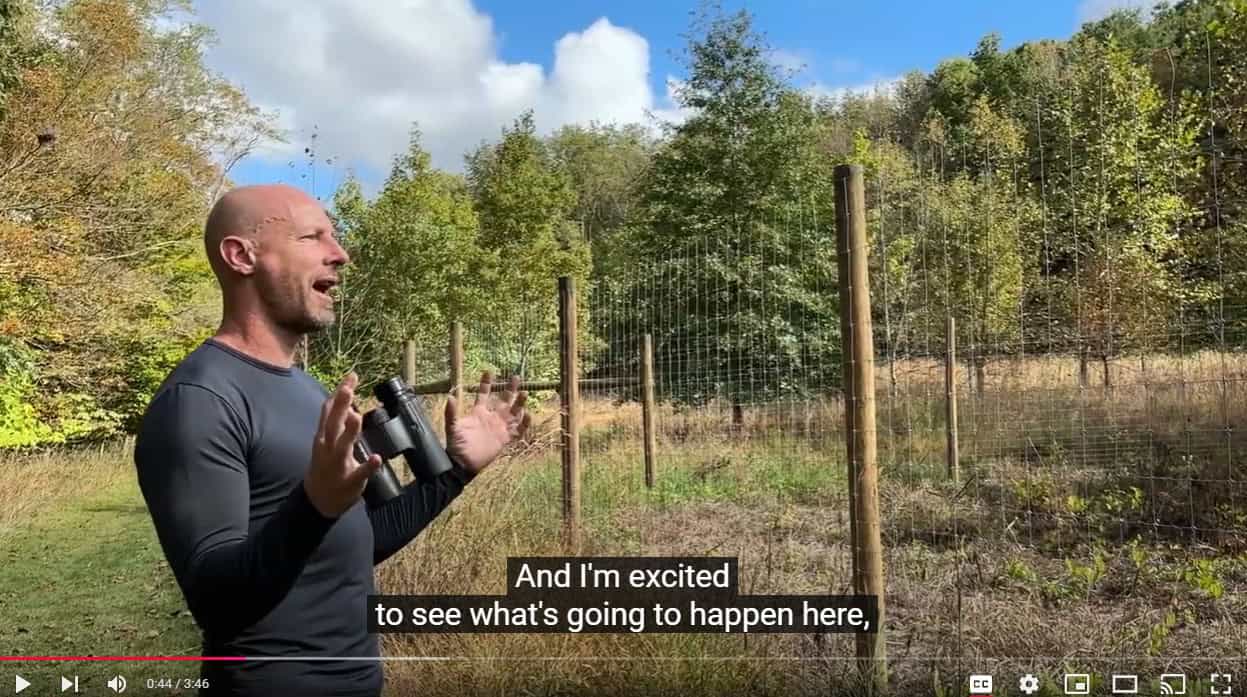Finding Balance: Deer Management At Natural Lands’ Preserves
October 15, 2024
A large male white-tailed deer walks in an autumn forest
FOR IMMEDIATE RELEASE
MEDIA, Pa., October 15, 2024 – The most dangerous wild animal in Pennsylvania causes hundreds of injuries or deaths every year. It is ruining crops, damaging timber harvests, and changing the forest composition. It’s the official state animal: the white-tailed deer, and its population is 10 times what our region’s forest can handle. Natural Lands, Greater Philadelphia’s oldest and largest land conservation nonprofit is working to manage the species’ impact on its 40+ nature preserves.
The organization recently installed a deer exclosure fence measuring 800 linear feet at its Hildacy Preserve, located in Media, Delaware County. The fence is eight-feet high to keep deer out but has openings in the wire that allow other animals to come and go freely.
“The concept is to fill this exclosure area with native plants—canopy and understory trees as well as shrubs—to replicate what would occur naturally at Hildacy Preserve were it not for the extreme deer pressure,” said Preserve Manager Mike Coll. “I’ll be planting in dense groupings inside the fence with a diverse mix of species. As these plants mature, they’ll provide food, shelter, and breeding habitat for insects, songbirds, and other wildlife.”
The organization hopes the exclosure is just the first of many they’ll install at their nature preserves, though funding is a limiting factor. The deer exclosure fencing and native plantings at Hildacy Preserve cost an estimated $18,000, more than half of which was funded by a grant from Aqua Essential and Pennsylvania Environmental Council.
Prior to European colonization, white-tailed deer were in balance with their forest habitat, according to experts from Penn State. The land we now call Pennsylvania had an estimated eight to 10 deer per square mile. For thousands of years, Native peoples kept deer populations in check through hunting. Large predators—such as mountain lions, bears, and wolves—were an added control. All of that changed with the arrival of settlers from across the Atlantic who hunted deer almost to local extinction.
In the early 1900s, the newly formed PA Game Commission began stocking deer brought in from other states and lobbied state government to enact legal restrictions on hunting. The deer population rebounded quickly. Today, Pennsylvania is home to an estimated 1.5 million white-tails, according to the state Game Commission. That’s about 32 deer for every square mile.
“High deer populations in most of Pennsylvania have greatly altered forest understories,” stated Roger Latham, Ph.D., an ecologist and conservation biologist with Continental Conservation and a former member of Natural Lands’ Board of Trustees. Latham has authored numerous reports on the ecological impact of deer. “To the casual observer the woods still look green, but they are much altered. In place of the diverse, multi-storied vegetation that was the norm, there are just a few species, either not preferred by deer or resilient to repeated browsing.”
Of course, deer populations impact more than just the forest and its flora and fauna. When our woodlands aren’t in balance, they can’t support the insects that make life possible. The loss of native plants and trees means caterpillars have no food to eat. Fewer caterpillars mean songbirds can’t feed their young. And the ripples continue through the interconnected web of which we humans are a part.
Deer overpopulation impacts human health more directly, too, largely through tick-borne illnesses and car crashes. Last year, 4,857 car crashes were caused by deer, according to PennDOT, resulting in 21 fatalities.
“The bottom line is that humans have been manipulating the deer population—and by extension the ecosystem—for thousands of years,” said Josh Saltmer, Natural Lands’ wildlife management coordinator. “Ironically, to keep from losing our forests, we are now compelled to continue the manipulation.”
Josh oversees Natural Lands’ successful deer hunting program, which has operated for 30 years. Hunters must apply to participate in the program, complete regular training and proficiency testing, and comply with strict safety protocols. The program emphasizes the removal of does as the best way to reduce and maintain populations at our nature preserves.
This year, several of Natural Lands’ preserve will be closed for hunting. Details are at natlands.org/visit.
- Binky Lee Preserve, Chester Springs, PA – closed December 2 – 7
- Bryn Coed Preserve, Chester Springs, PA – closed December 9 – 14
- ChesLen Preserve, Coatesville, PA – closed December 2 – 7
- Mariton Wildlife Sanctuary, Easton, PA – closed November 30 – December 14
- Stroud Preserve, West Chester, PA – closed December 9 – 14
Learn more about the deer exclosure fence at Hildacy Preserve (video).

Natural Lands is dedicated to preserving and nurturing nature’s wonders while creating opportunities for joy and discovery in the outdoors for everyone. As the Greater Philadelphia region’s oldest and largest land conservation organization, Natural Lands—which is member supported—has preserved more than 135,000 acres, including 40+ nature preserves and one public garden totaling more than 23,000 acres. Nearly five million people live within five miles of land under the organization’s protection. Land for life, nature for all. natlands.org.
Please note: “Natural Lands” is the organization’s official operating name and should be used instead of its legal designation (Natural Lands Trust, Inc.).
Media Inquiries:
Kit Werner, Senior Director of Communications
610-353-5587 ext. 267
###
next post
Bird Walk
October 13, 2024
Join us next Saturday, October 19 for a bird walk at Crow’s Nest Preserve. Held in partnership with the Chester County Birding Club.
